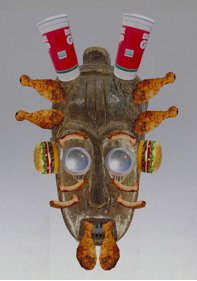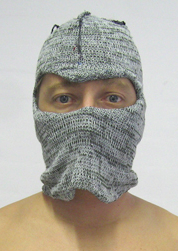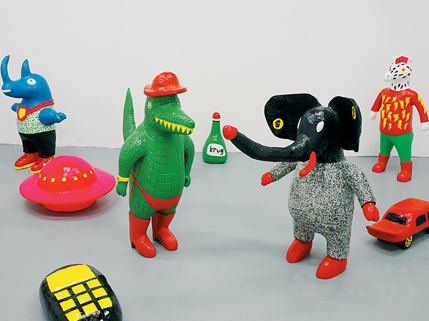02\08\2011
Written by Narayana

Cameron Platter: A State-of-the-Art African
Cameron Platter gives Blend an exclusive sneak peak at his new series of Bronze sculptures that will be exhibited as part of his solo show at Hilger Contemporary Gallery in Vienna this coming May 2012.
“The new mask series is a move away from highly fantastical/ super fictional character work. Instead they use the best of both worlds; mixing found/ existing/ historical themes (masks, Benin bronzes, craftsmanship) with the concerns of contemporary SA (cellphones, fast food, murder weapons, penis enlargers)” — Cameron Platter
written by Claire Breukel
Cameron Platter is born in Johannesburg, South Africa. He has exhibited extensively throughout South Africa and Europe, and his work is currently in the exhibition ‘Impressions from South Africa, 1965 to Now’ at MOMA, New York, and is part of the permanent collection. His work has also been shown at Centre Georges Pompidou, Paris; Haus der Kulturen der Welt, Berlin; South African National Gallery, Cape Town; and the Dakar Biennale, Dakar.
Way before the South African rap-rave ‘Die Antwoord’ had begun to define their identity within sub-culture, Cameron Platter has carved out a language
in his artwork that discusses the misconceptions, the idealisms as well as the flux of his identity: as a young creative African male, an artist and a commentator — amongst other possible descriptions. Having been trained as
a painter, Platter diversified his style to create sprawling and obsessive pencil crayon drawings mimicking traditional linocuts, videos using low-tech stop frame animation painstakingly creating each frame, life-size woodcarvings
of characters that are colorful and highly glossy, and now, bronze castings
of a new take on the African mask. His adeptness at handling a diversity of media is further solidified by a lucid thematic that runs through his work.
A theme that specifically discusses the realities and absurdities of what it means to be an artist living and working in contemporary Africa.
Platter explains “Real life is far more absurd than anything sucked from fiction, so I’m preferring to base my narratives on real-life stuff that I see unfold around me.”
[pro-player width=’448′ height=’420′ image=’http://www.blendbureaux.com/wp-content/uploads/2011/08/CameronPlatter-b-w-ass.png’]http://dl.dropbox.com/u/8912390/Butwa.mp4[/pro-player]
Black Up That White Ass II. 2009. Video, color, sound, 26 min., 55 sec
To contextualize his identity, Cameron Platter appropriates mediums of art-making characteristic of historical South African art practice. He recreates the Aesthetic of black and white linocuts made by African printmakers as well as the techniques of traditional woodcarvings creating sculptures from indigenous Jacaranda wood, and transforms these traditional media by infusing them with subject matter drawn from his life, his environment as well as pop culture. The result is that he delves in to the everyday, observing behavior related to culture and contemporary consumption. Lastly, he adds otherworldliness to his narratives including aliens, spaceships and a provocative narrative that would make ones grandmother blush. Actually, in truth, one of Platter’s litmus tests is to show his videos to his Grandmother and if she blushes, he doesn’t show them…
[pro-player width=’448′ height=’420′ image=’http://www.blendbureaux.com/wp-content/uploads/2011/08/CameronPlatter-videostill.png’]http://dl.dropbox.com/u/8912390/Old%20Fashion.mp4[/pro-player]
The Old Fashion, 2010. (animated video)
The colors, iconography and flavor of the work are reflective of contemporary Africa, also encapsulating the influence of American (and global) culture, lending these nostalgic art mediums an exotic and contemporary sexiness. Platter’s woodcarvings become brightly colored characters that look like props from his videos; hand drawings become dynamic dioramas echoing the narratives of advertising campaigns of African medical and self-help remedies, faith-based slogans and everyday mass media; videos depict a mix of animal and human characters enjoying the good life. These characters have gusto, sexy strippers, drug lords, pimps and even zebra aliens who eventually of course zap the bad guys. Thick with satire these hedonistic storylines unfold like narratives in a James Bond movie. Through parties, drama and bloodshed the bad guys inevitably lose and it becomes evident that Platter is acting out desired justice. He of course is the ultimate mastermind.
Beyond the surface of fantastical imagery Platter’s work is plugging away at some fundamental issues. He makes fun of the stereotypes associated with what is perceived to be ‘African’ by melding traditional and contemporary art practice. And in doing so, he overturns the preconception associated with these styles. Secondly, by acknowledging and incorporating the history of art practice in Africa, Platter places himself into contexts inserting his identity in the timeline of art practice — an identity that has for some time been in flux, and now is beginning to solidify.

to visit the website of the artist:
Cameron Platter
Claire Breukel is a Contemporary art curator and writer based in New York and Miami. She is interested in artwork that falls out of conventional modes of exhibition.


